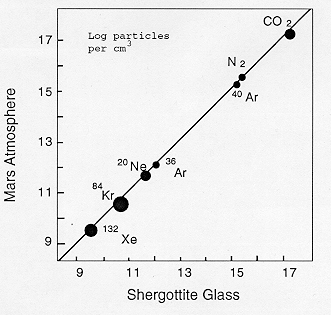|
I. Meteorites from Mars?
A few of the world's known meteorites (~28) are
believed to be pieces of Mars that have traveled to Earth following a
massive asteroidal or cometary impact with the Martian surface.
Because all of these meteorites do not contain any free metal,
as many meteorites do, they cannot be found using a metal detector.
Therefore, people must observe their fall to Earth, or find them in
a conspicuous location, such as the Antarctic ice sheets. The
National Science Foundation
supports annual expeditions to Antarctica to collect meteorites of
all types through the
Antarctic Search for Meteorites (ANSMET) Program. This program
has collected several Martian meteorites since 1977.
The Martian meteorites traditionally have been referred to as "SNC"
meteorites. They were so named because all of the meteorites could be
classified in terms of three primary igneous classes based on their
composition: (S)hergottites (basalts and lherzolites), (N)akhlites
(clinopyroxenites), and the (C)hassignites (dunites). Recently,
another meteorite named ALH 84001 (orthopyroxenite), was recognized to
be a Martian meteorite that does not fall into one of these three
classes. For more information on each of the meteorite samples, see these
NASA web pages.
So how do we know that these are pieces of Mars, rather than of
an asteroid, as in the case of most meteorites? There are
primary characteristics of these meteorites that distinguish them
from the asteroid-derived meteorites.
- First, all of these meteorites, with the exception of one, are
geologically young, with ages of crystallization ranging from 180
million years (Myr) to 1.3 billion years (Gyr). This may seem old to
us, but our solar system is roughly 4.5 billion years old! So most of
these rocks were "born" only in the last quarter (or less) of our solar
system's existence. Most of the asteroids are small compared to
planets, and became fully solid (crystallized) soon after the formation
of the solar system, therefore, any rocks much younger than 4.5 Gyr
were probably formed on a body that was pretty large and geologically
active, like a planet such as Mercury, Venus, Earth, or Mars.
- Second, when a molten rock crystallizes and becomes solid, gases
get trapped in the minerals in the rock. All of the terrestrial
planets have different abundances of these gases. When scientists
looked at the trapped gases in these meteorites, they found that the
abundances didn't match the known gas abundances found in rocks on
Earth. Luckily, the Viking landers measured the gases of the Martian
atmosphere from the planet's surface. When the abundances of gases in
these meteorites are compared to the abundances of gases in the Martian
atmosphere, it turns out that there is an almost 1:1 correlation
(Figure 1), strongly suggesting that these meteorites are rocks
that were crystallized on Mars.
 Figure 1. Comparison of gas abundances in shergottite EET79001
and the Martian atmosphere. From the NASA Meteorites page.
Figure 1. Comparison of gas abundances in shergottite EET79001
and the Martian atmosphere. From the NASA Meteorites page.
Proceed to Why Thermal Emission
Spectra of Martian Meteorites?
Return to Emission Spectroscopy
of Martian Meteorites
|



